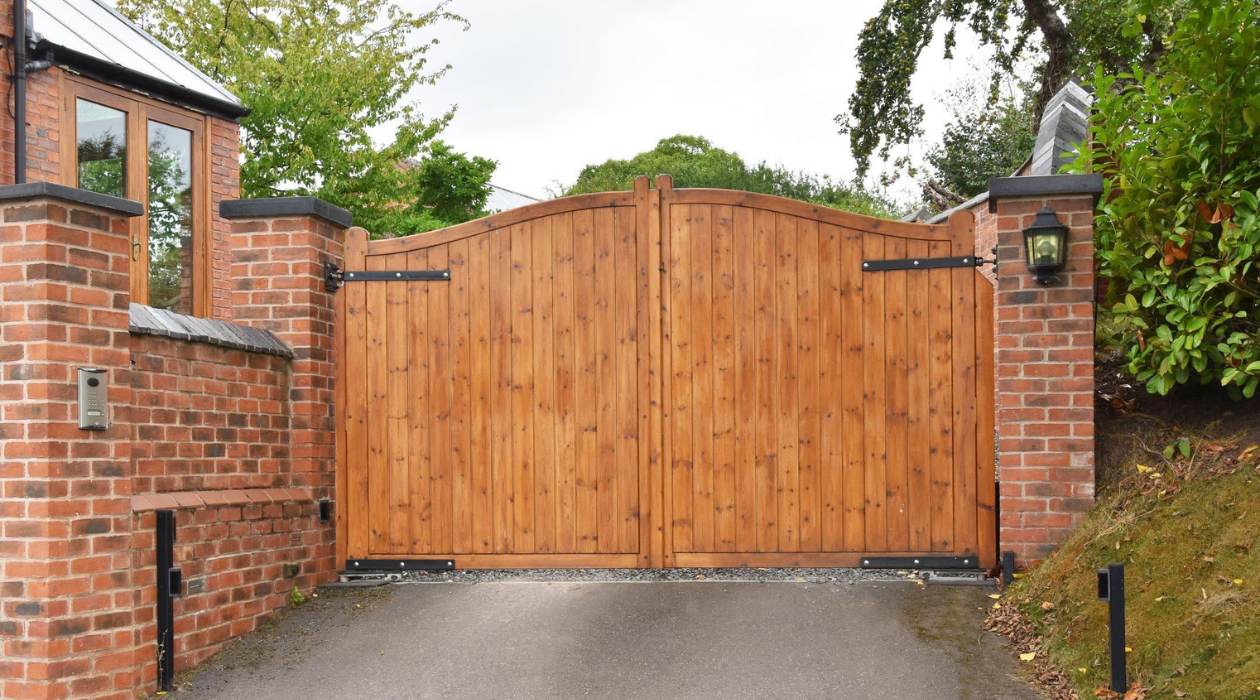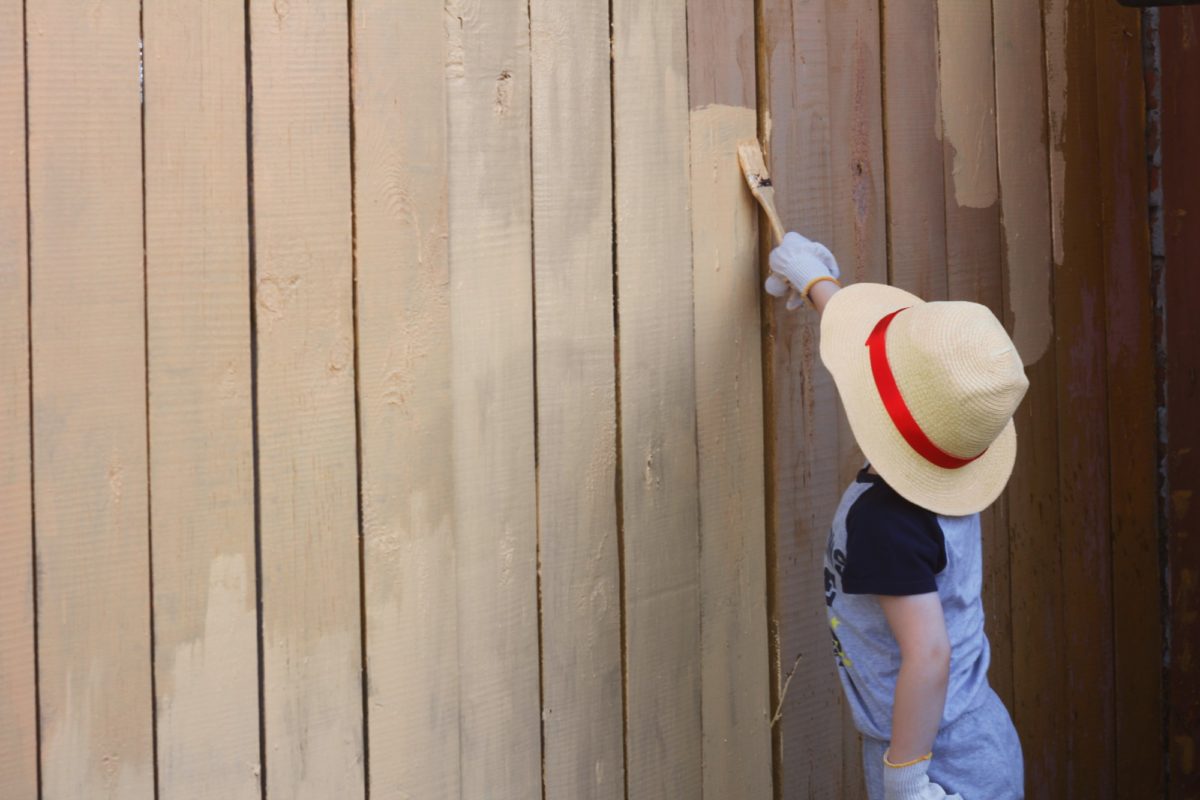

Articles
How To Install A Driveway Gate
Modified: October 22, 2024
Learn the step-by-step process of installing a driveway gate with our informative articles. Achieve security and aesthetics for your property efficiently and easily.
(Many of the links in this article redirect to a specific reviewed product. Your purchase of these products through affiliate links helps to generate commission for Storables.com, at no extra cost. Learn more)
Introduction
Welcome to our comprehensive guide on how to install a driveway gate. Driveway gates can add elegance, security, and functionality to your property, making them a popular choice for homeowners. Whether you’re looking to enhance the curb appeal of your home or increase the privacy and security of your property, installing a driveway gate can be a worthwhile investment.
In this guide, we will provide you with step-by-step instructions on how to install a driveway gate. We will cover everything from gathering the necessary tools and materials to securing the gate in place. Whether you’re a seasoned DIY enthusiast or a beginner, this guide will help you navigate through the installation process.
Installing a driveway gate may seem like a daunting task, but with the right tools, materials, and guidance, it can be a straightforward and rewarding project to undertake. It’s essential to follow the proper steps to ensure a successful installation that will stand the test of time.
Before we delve into the installation process, let’s take a moment to understand the different types of driveway gates available. Driveway gates come in various styles, materials, and designs, allowing you to choose the one that suits your preferences and requirements.
Some common types of driveway gates include:
- Swing gates: These gates open inward or outward, similar to a regular door. They can swing open in a single or double configuration, depending on the width of your driveway.
- Sliding gates: Sliding gates operate by sliding horizontally along a track. They are a suitable option when space is limited or if the terrain is uneven.
- Automatic gates: Automatic gates are equipped with an electric motor that allows for convenient remote or keypad operation. They offer added convenience and security.
- Manual gates: Manual gates are operated by manually opening and closing them. They are a more affordable option but don’t provide the same level of convenience as automatic gates.
Now that we have an overview of the different types of driveway gates let’s get started with the installation process. Before you begin, make sure to check with your local authorities regarding any permits or regulations related to driveway gate installations.
Key Takeaways:
- Installing a driveway gate involves careful planning, precise measurements, and secure installation of gate posts and panels. Prioritizing safety, following local regulations, and regular maintenance are essential for a successful and rewarding DIY project.
- Choosing the right type of driveway gate, gathering necessary tools and materials, and testing the gate’s operation are crucial steps in ensuring functionality, security, and aesthetic appeal. Proper alignment, clearance, and securing the gate in place contribute to a well-installed and long-lasting driveway gate.
Read more: How To Make Driveway Gates
Step 1: Gather the necessary tools and materials
Before you begin the installation process, it’s essential to ensure you have all the necessary tools and materials. Having everything prepared in advance will help streamline the installation and prevent delays. Here’s a list of the tools and materials you’ll need:
Tools:
- Measuring tape
- Post hole digger or shovel
- Level
- Drill with various drill bits
- Screwdriver (Phillips and flathead)
- Wrench or pliers
- Hammer
- Saw (for cutting wood, if necessary)
- Safety glasses
Materials:
- Driveway gate (swing, sliding, automatic, or manual)
- Gate posts
- Gate panels or gate frame
- Gate hardware (hinges, latch, screws, bolts)
- Concrete mix
- Gravel
- Wood stakes
- Nails or screws
- String or twine
- Gate opener (if installing an automatic gate)
Depending on the type and design of the driveway gate you choose, the specific tools and materials required may vary slightly. It’s always a good idea to refer to the manufacturer’s instructions or installation manual for any additional tools or materials that may be specific to your chosen gate.
Once you have gathered all the necessary tools and materials, ensure that they are in good working condition. Check for any missing or damaged parts and replace them as needed. It’s important to have high-quality tools and materials to ensure the durability and functionality of your driveway gate.
Additionally, it’s crucial to prioritize safety during the installation process. Make sure to wear appropriate safety gear, such as safety glasses, gloves, and sturdy footwear. If you’re unsure about using any tool or performing a specific task, consult a professional or seek guidance before proceeding.
With all the tools and materials in hand, you’re now ready to move on to the next step: measuring and marking the location of the driveway gate.
Step 2: Measure and mark the location of the driveway gate
Once you have gathered all the necessary tools and materials, the next step is to measure and mark the location where the driveway gate will be installed. Properly measuring and marking the area is crucial for ensuring the gate fits correctly and functions smoothly. Follow these steps:
Read more: How To Build A Metal Gate For Driveway
1. Determine the gate opening:
Measure the width of your driveway to determine the width of the gate opening. This will depend on whether you are installing a single gate or a double gate. Single gates typically have an opening width of 10 to 14 feet, while double gates can range from 14 to 24 feet. Consider factors such as the size of vehicles that need to pass through the gate and any clearance requirements.
2. Mark the centerline and gate posts:
Using a measuring tape, locate the centerline of the driveway. This will help ensure that the gate is installed symmetrically. Mark the centerline using a temporary marker or tape.
Next, determine the location of the gate posts. These will be the supporting structures for your driveway gate. Measure the width of the gate panel or frame, and mark the outer edges of the gate posts accordingly. Ensure that there is enough clearance for the gate to open and close smoothly without obstructions.
3. Establish the gate height:
Decide on the desired height of the gate. This will depend on your preferences and any specific requirements you may have. Measure the height from the ground and mark the desired height on the gate posts.
It’s important to consider factors such as the slope of the driveway, the clearance needed for vehicles, and any aesthetic considerations when determining the gate height.
4. Check for level and alignment:
Using a level, ensure that the gate posts are plumb (perfectly vertical) and aligned with each other. Make any necessary adjustments by adding or removing soil or gravel at the base of the posts until they are level and aligned.
Taking the time to accurately measure and mark the location of the driveway gate will help ensure a seamless installation and prevent any issues down the line. Once you have completed this step, you can proceed to the next step: preparing the ground for installation.
Read more: How Much Do Driveway Gates Cost
Step 3: Prepare the ground for installation
In order to ensure a stable and secure installation for your driveway gate, it is important to properly prepare the ground beforehand. This step involves clearing the area, leveling the ground, and making provisions for proper drainage. Follow these steps to prepare the ground:
1. Clear the area:
Remove any obstacles, vegetation, or debris from the area where the gate will be installed. This includes rocks, roots, branches, and any other objects that may interfere with the gate’s operation or stability.
2. Mark the gate posts:
Using the marks you made in Step 2, determine the exact location of the gate posts. Place wood stakes in the ground at each marked point to indicate the position of the gate posts. This will help you visualize the installation area and ensure accuracy during the digging process.
3. Dig the post holes:
Using a post hole digger or shovel, dig the holes for the gate posts. The depth and diameter of the holes will depend on the size and type of the gate posts. Generally, a depth of around 2 to 3 feet and a diameter of 8 to 12 inches should be sufficient.
Make sure the holes are dug evenly and that the gate posts will fit securely inside. Remove any excess dirt or rocks from the holes to ensure a proper fit.
Read more: How To Install Fence Gate
4. Prepare for proper drainage:
Consider the drainage needs of your driveway gate. If the area is prone to heavy rain or flooding, it is important to provide adequate drainage to prevent water pooling around the gate posts.
You can ensure proper drainage by adding a layer of gravel at the bottom of the post holes. This will allow water to drain away from the posts and prevent them from becoming waterlogged.
5. Verify post alignment and level:
Double-check the alignment and levelness of the gate posts. Use a level and a measuring tape to ensure that the posts are perfectly upright and aligned with each other. Make any necessary adjustments by adding or removing soil or gravel at the base of the post holes.
By properly preparing the ground, you lay the foundation for a secure and stable installation of your driveway gate. Taking the time to clear the area and ensure proper drainage will help prevent common issues such as sagging or leaning gate posts. Once the ground is prepared, you are ready to move on to the next step: setting the gate posts.
Step 4: Set the gate posts
Now that you have prepared the ground, it’s time to set the gate posts. The gate posts are crucial for providing stability and support to the driveway gate. Follow these steps to set the gate posts:
1. Place the gate posts in the holes:
Carefully lower the gate posts into the prepared post holes. Make sure they are seated securely at the bottom and stand upright. If necessary, ask a helper to assist you in holding the posts in place.
2. Check the alignment and levelness:
Using a level, check that each gate post is perfectly upright. Adjust the position of the posts as needed to ensure they are plumb. Also, verify that the gate posts are aligned with each other and level across the top.
3. Secure the gate posts:
To secure the gate posts in place, you will need to fill the post holes with concrete. This will provide strength and stability to the posts. Mix the concrete according to the manufacturer’s instructions in a wheelbarrow or mixing container.
Pour the concrete mixture into each post hole, ensuring that it completely fills the hole around the gate post. Use a shovel or post level to slightly slope the concrete away from the gate post to promote proper drainage.
4. Allow the concrete to cure:
Once the post holes are filled with concrete, allow the mixture to cure for the recommended period of time. This typically ranges from 24 to 48 hours, but refer to the instructions on the concrete packaging for specific curing times.
During the curing process, avoid disturbing or putting any weight on the gate posts to allow the concrete to harden properly. Cover the concrete base with plastic or a tarp to protect it from rain or excessive moisture during this time.
5. Verify the stability:
After the concrete has fully cured, check the stability of the gate posts. Gently shake each post to ensure it is firmly set in the ground. If any post feels loose, you may need to reinforce the base by adding additional concrete or gravel around the post.
Setting the gate posts correctly is crucial for the long-term stability and functionality of your driveway gate. Taking the time to ensure proper alignment and using concrete for secure anchoring will prevent issues such as leaning or sagging of the gate. With the gate posts securely set, you can now move on to the next step: installing the gate panels or frame.
Read more: How To Install Driveway Pavers
Step 5: Install the gate panels or gate frame
Now that the gate posts are securely set, it’s time to install the gate panels or frame. The installation process will vary depending on the type of gate you have chosen, whether it’s a swing gate or a sliding gate. Follow these steps to install the gate panels or gate frame:
1. Align the gate panels or frame:
If you have individual gate panels, align them with each other to ensure a seamless look. If you have a gate frame, make sure it is positioned correctly between the gate posts. Use a level to verify that the gate panels or frame are plumb and level.
2. Attach the gate panels or frame to the gate posts:
Using the appropriate hardware provided with your gate, attach the gate panels or frame to the gate posts. This may involve screwing or bolting the gate panels directly to the gate posts or attaching them to hinges for swing gates.
Make sure the gate panels or frame are securely and evenly attached to the gate posts. Use a level to double-check that everything is still plumb and level during the installation process.
3. Test the gate operation:
Once the gate panels or frame are installed, test the gate’s operation. Open and close the gate to ensure it moves smoothly, without any obstructions or sticking. Make any necessary adjustments to the gate panels or frame to ensure proper functionality.
Read more: How To Install Driveway Lights
4. Fine-tune the gate alignment:
If needed, you can fine-tune the gate alignment to ensure it closes properly and aligns with the gate latch. This may involve adjusting the hinges or making minor modifications to the gate hardware.
5. Adding finishing touches:
Depending on your preferences and the type of gate you have, you can add finishing touches to enhance the gate’s appearance and functionality. This may include adding decorative elements, such as caps or finials to the gate posts, or applying a protective sealant or paint to the gate panels or frame.
By properly installing the gate panels or gate frame, you ensure the functionality and visual appeal of your driveway gate. Take your time during this step to ensure everything is properly aligned and securely attached. With the gate panels or frame in place, you are now ready to move on to the next step: attaching the gate hardware.
Step 6: Attach the gate hardware
Attaching the gate hardware is an important step in the installation process as it ensures the proper functionality and security of your driveway gate. The specific hardware required may vary depending on the type of gate you have chosen, such as swing gate or sliding gate. Follow these steps to attach the gate hardware:
1. Install the gate hinges:
If you have a swing gate, start by attaching the gate hinges to the gate panels or gate frame. Place the hinges on the proper side of the gate, ensuring they are positioned at a suitable height. Use the provided screws or bolts to secure the hinges in place.
Make sure the hinges are securely fastened and aligned, allowing the gate to swing freely without any obstructions. Use a level to ensure the gate panels or frame are still plumb and level after attaching the hinges.
Read more: How To Install A Driveway Drainage System
2. Mount the gate latch:
Next, install the gate latch. This is the mechanism that allows you to secure the gate in a closed position. Position the latch on the gate frame or gate panel opposite to the hinges. Ensure that it aligns properly with the latch receiver mounted on the adjacent gate post.
Secure the latch in place using the provided screws or bolts. Test the latch to ensure it engages and disengages smoothly, securely holding the gate in place when closed.
3. Attach any additional gate hardware:
Depending on the type of gate and your specific requirements, you may need to attach additional gate hardware. This can include gate stops to limit the gate’s opening and closing range, gate handles for easy operation, or gate wheels for smooth sliding gate function.
Refer to the manufacturer’s instructions and follow the recommended installation process for each specific piece of gate hardware. Ensure they are securely fastened and properly aligned for optimal performance.
4. Test the gate operation:
Once all the gate hardware is attached, test the gate’s operation. Open and close the gate multiple times to ensure that it functions smoothly and securely. Check that the latch engages properly and that any additional gate hardware performs as intended.
If any issues or adjustments are needed, make the necessary modifications to the gate hardware to ensure optimal performance and security.
By attaching the gate hardware correctly, you ensure that your driveway gate is fully functional, secure, and easy to operate. Take your time during this step to ensure proper alignment and secure fastening of all hardware components. With the gate hardware in place, you are now ready to move on to the next step: testing and adjusting the gate operation.
Step 7: Test and adjust the gate operation
After attaching the gate hardware, it’s important to thoroughly test the operation of your driveway gate to ensure it functions smoothly and securely. Performing a thorough test will allow you to identify any potential issues and make necessary adjustments. Follow these steps to test and adjust the gate operation:
Read more: How To Install Belgian Block Driveway Edging
1. Open and close the gate:
Operate the gate by opening and closing it multiple times. Pay close attention to how the gate moves, ensuring it opens and closes smoothly without any obstructions or sticking points.
Observe the gate’s movement, checking for any signs of misalignment, excessive friction, or resistance. Make note of any areas that need adjustment or fine-tuning during the testing process.
2. Check for proper clearances:
While operating the gate, check for any potential clearance issues. Make sure the gate does not scrape against the ground or any surrounding structures. Verify that there is sufficient clearance for vehicles and pedestrians to pass through the gate comfortably.
3. Adjust hinges or sliding mechanisms:
If you notice any misalignment or sticking points during the testing process, you may need to make adjustments to the gate hinges or sliding mechanisms. Use a level to ensure the gate is plumb and level, and adjust the hinges or sliding mechanisms as necessary.
If the gate is binding or rubbing against the gate posts or frame, you may need to make slight adjustments to ensure smooth operation. This can involve tightening or loosening the hinge bolts or adjusting the sliding track for sliding gates.
4. Fine-tune the latch:
Ensure that the gate latch engages and disengages properly. Adjust the latch mechanism or striker plate to ensure a secure and reliable closure. The latch should hold the gate firmly in place when closed, without any excessive play or movement.
If necessary, lubricate the latch mechanism to ensure smooth operation. Check that the latch can be easily operated from both sides of the gate.
Read more: How Much For A Fence Gate
5. Test gate opener (if applicable):
If you have installed an automatic gate opener, test its functionality. Verify that the gate opener operates smoothly and without any issues. Check the remote control, keypad, or any other control method to ensure proper communication with the gate opener.
Make sure the gate stops and reverses if it encounters any obstacles during the closing process. Adjust the sensitivity settings of the gate opener as needed.
By thoroughly testing and adjusting the gate operation, you ensure that your driveway gate functions properly and provides the desired security and convenience. Take the time to make necessary adjustments to ensure a smooth and reliable operation. With the gate operation tested and adjusted, you can now move on to the final step: securing the gate in place.
Step 8: Secure the gate in place
The final step in the installation process is to secure the gate in place. This ensures that your driveway gate remains stable, secure, and functions optimally. Follow these steps to securely fasten the gate:
1. Check gate alignment:
Before securing the gate, double-check the alignment and levelness. Ensure that the gate panels or frame are still plumb and level, and that they align properly with the gate posts. Make any necessary adjustments to ensure proper alignment.
2. Secure gate panels or frame:
Using the appropriate hardware provided with your gate, securely fasten the gate panels or frame to the gate posts. This may involve using screws, bolts, or other fasteners. Ensure that the gate is firmly attached to the gate posts, providing stability and security.
Double-check the security of all fasteners, tightening them as needed to prevent any loosening over time. Use a wrench or pliers to ensure a tight and secure fit.
3. Reinforce gate frame (if necessary):
If you have a gate frame, consider reinforcing it for added stability. This may involve adding diagonal braces or additional support structures to strengthen the frame. Reinforcements will depend on the size and weight of the gate and the specific requirements of your setup.
Consult the manufacturer’s instructions or seek professional guidance if you need to reinforce the gate frame. Ensuring a solid and stable frame will enhance the longevity and performance of your driveway gate.
4. Check gate clearance:
Verify that there is proper clearance for the gate to open and close without obstructions. Ensure that the gate does not scrape against the ground or any surrounding structures. Make any necessary adjustments to prevent clearance issues.
5. Test gate operation:
After securing the gate, test its operation one final time. Open and close the gate to ensure it moves smoothly and securely. Verify that the latch engages and disengages properly, and that any gate hardware or mechanisms function as intended.
6. Consider additional security measures:
Depending on your desired level of security, you may want to consider additional measures to enhance the security of your gate. This can include installing a lock or security system, adding security cameras, or integrating with an access control system.
Consult with a security professional to determine the best security measures for your specific needs and location.
By securing the gate in place, you ensure that your driveway gate remains stable, secure, and operates properly. Take the time to carefully fasten the gate and make any necessary adjustments. Once you have completed this step, you can step back and appreciate your newly installed driveway gate, providing functionality, security, and aesthetic appeal to your property.
Read more: How Wide Is A Fence Gate
Conclusion
Congratulations! You have successfully completed the installation process for your driveway gate. By following the step-by-step instructions in this guide, you have gained the knowledge and skills to install a driveway gate that enhances the security, privacy, and curb appeal of your property.
Installing a driveway gate may have seemed like a daunting task at first, but with the right tools, materials, and guidance, it can be a rewarding DIY project. Taking the time to properly measure and mark the location, prepare the ground, set the gate posts, install the gate panels or gate frame, attach the gate hardware, test and adjust the gate operation, and ultimately secure the gate in place ensures a successful installation.
Throughout the installation process, it’s important to prioritize safety. Always wear appropriate safety gear, follow manufacturer’s instructions, and consult professionals when needed. Safety precautions, such as using safety glasses and gloves, can help prevent accidents and injuries during the installation process.
Remember to adhere to any local regulations or permits required for installing a driveway gate. Check with your local authorities to ensure compliance with any restrictions, guidelines, or neighborhood rules.
A well-installed driveway gate not only adds functionality and security to your property but also enhances its visual appeal. With a variety of gate types, styles, and materials available, you can choose a driveway gate that suits your preferences and complements the overall aesthetics of your home.
Regular maintenance and care will prolong the lifespan of your driveway gate. Inspect the gate periodically, check for any signs of wear or damage, and address any issues promptly. Lubricate moving parts, such as hinges or sliding mechanisms, as needed to ensure smooth operation. Additionally, consider applying a protective sealant or paint to protect the gate from the elements.
Now that you have completed the installation of your driveway gate, take a moment to appreciate the added security, functionality, and beauty it brings to your property. Enjoy the convenience of a well-operating gate while creating a welcoming entrance to your home.
Thank you for using this comprehensive guide on how to install a driveway gate. We hope that your new driveway gate brings you years of satisfaction and enhances the value of your property.
Frequently Asked Questions about How To Install A Driveway Gate
Was this page helpful?
At Storables.com, we guarantee accurate and reliable information. Our content, validated by Expert Board Contributors, is crafted following stringent Editorial Policies. We're committed to providing you with well-researched, expert-backed insights for all your informational needs.





0 thoughts on “How To Install A Driveway Gate”